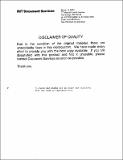| dc.contributor.advisor | George R. Ricker and Victoria M. Kaspi. | en_US |
| dc.contributor.author | Pivovaroff, Michael James, 1971- | en_US |
| dc.contributor.other | Massachusetts Institute of Technology. Dept. of Physics. | en_US |
| dc.date.accessioned | 2005-09-27T20:02:03Z | |
| dc.date.available | 2005-09-27T20:02:03Z | |
| dc.date.copyright | 2000 | en_US |
| dc.date.issued | 2000 | en_US |
| dc.identifier.uri | http://hdl.handle.net/1721.1/9026 | |
| dc.description | Thesis (Ph.D.)--Massachusetts Institute of Technology, Dept. of Physics, 2000. | en_US |
| dc.description | Includes bibliographical references. | en_US |
| dc.description.abstract | This dissertation concerns the use of charge coupled devices (CCDs) for X-ray astronomy. Part I of this thesis focuses on the calibration of the Advanced CCD Imaging Spectrometer (ACIS), one of the two primary focal plane instruments on the Chandra X-ray Observatory. I begin by presenting a series of measurements made using undispersed synchrotron radiation. I analyzed the results of these experiments to extract parameters necessary to model the absolute detection efficiency of CCDs used as reference standards for ACIS characterization. I also discuss a novel "mesh" technique I pioneered to non-destructively measure the sub-pixel structure of CCDs, including the channel stops and gates. This work also provided a valuable tool for understanding the way charge is collected inside certain regions of the ACIS detectors. Guided by the results of the mesh experiments, I performed additional measurements to constrain recombination effects in the channel stops. Part II of this thesis concerns the X-ray properties of rotation-powered (radio) pulsars. High energy observations serve as a powerful diagnostic of the energetics and emission mechanisms of neutron stars. Associations between pulsars and the remnants of their supernovae provide independent measures of the distance and age of neutron stars, as well as constraints on their initial velocities, magnetic fields, and spin periods. I analyze ASCA and ROSAT observations of three young pulsars which are particularly well-suited for addressing these issues. I also present observations of the rotation-powered pulsar with the highest known magnetic field, and describe how the results relate to anomalous X-ray pulsars, another type of neutron star. Finally, I analyze Chandra observations of the supernova remnant Cas A. These data fully demonstrate the capabilities of ACIS and reveal a previously unknown point source at the center of the remnant. | en_US |
| dc.description.statementofresponsibility | by Michael James Pivovaroff. | en_US |
| dc.format.extent | 266 p. | en_US |
| dc.format.extent | 20651105 bytes | |
| dc.format.extent | 20650862 bytes | |
| dc.format.mimetype | application/pdf | |
| dc.format.mimetype | application/pdf | |
| dc.language.iso | eng | en_US |
| dc.publisher | Massachusetts Institute of Technology | en_US |
| dc.rights | M.I.T. theses are protected by copyright. They may be viewed from this source for any purpose, but reproduction or distribution in any format is prohibited without written permission. See provided URL for inquiries about permission. | en_US |
| dc.rights.uri | http://dspace.mit.edu/handle/1721.1/7582 | |
| dc.subject | Physics. | en_US |
| dc.title | X-ray astronomy with CCDs : calibration of the advanced CCD imaging spectrometer and observations of rotation-powered pulsars | en_US |
| dc.title.alternative | X-ray astronomy with charged coupled devices | en_US |
| dc.type | Thesis | en_US |
| dc.description.degree | Ph.D. | en_US |
| dc.contributor.department | Massachusetts Institute of Technology. Department of Physics | |
| dc.identifier.oclc | 47839836 | en_US |
